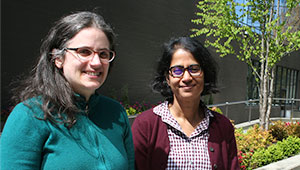Doctor, how long do I have? New tool estimates cancer survival

Susan Brandzel describes how patients and providers can now use a data-driven, online tool to discuss and plan for cancer care.
By Susan Brandzel, MPH, project manager at Kaiser Permanente Washington Health Research Institute
It’s a common and much-feared health care scenario: Patient sees provider about a symptom, provider examines patient and runs tests, provider utters the words no one wants to hear: “You have cancer.”
Not only is this a scary message for a patient to receive, but it is a difficult one for providers to deliver. What makes it particularly emotional is that there has always been a strong association, albeit not always accurate, between cancer and death. For providers, the clinical complexity of cancer and the myriad ways it can present and behave, makes it incredibly challenging to explain a diagnosis, navigate clinical decision-making, and provide emotional support for patients and their families.
Leveraging a national data resource
To help patients, their personal network, and providers steer through the murky waters of talking about cancer treatment and survival, entrepreneurs Stephen Buck, Omar Mehmood, and their team at Courage Health recently developed and launched a website, www.cancersurvivalrates.com, which allows users to plug in customized, relevant information about themselves and their cancer diagnosis to get a data-driven, evidence-based, survival estimate.
Cancersurvivalrates.com uses “predictive models,” which are mathematical calculations based on data from large groups of people with the same conditions. To put it crudely, if you take, for example, 10,000 people with the same type and stage of cancer, what happened to them over time? And if you divide that group by sex and or by age groups, what happened within those subgroups? The answers to these questions then allow a statistician to generate survival predictions based on a patient’s biologic characteristics.
The data behind cancersurvivalrates.com comes from the Surveillance, Epidemiology, and End Results Program (SEER), a system funded by the National Cancer Institute that generates a confidential, highly- detailed data repository that tracks a significant proportion of U.S. cancer cases starting at the time of diagnosis. This same robust and reliable SEER data is behind much of the cancer research that scientists at Kaiser Permanente Washington Health Research Institute (KPWHRI) are doing. SEER data are used to identify potential cancer risk factors and predict survival rates by investigators such as Jessica Chubak, Aruna Kamineni, and Erin Bowles, as well as by the Breast Cancer Surveillance Consortium, whose Statistical Coordinating Center is based at KPWHRI and directed by Ellen O’Meara.
Big data for big decisions
Using the cancersurvivalrates.com website is simple. Upon accessing the landing page, a user will identify whether they are a patient (or other lay person) or provider, then use the site’s template to estimate survival rates based on age, sex, cancer type and stage, and time since diagnosis. In large font, at the top of the screen, the survival rate is posted and will change based on how each of these variables is characterized by the user.
In addition to furnishing survival calculations, cancersurvivalrates.com also recommends patients ask their providers three common questions pondered among people with newly diagnosed cancer:
- “What’s your estimate of my survival rate?”
- “Can you verify my stage and grade (plus an explanation of what stage and grade are)?”
- “What can I do to be more comfortable?”
KPWHRI studies survival predictions
While cancersurvivalrates.com is not directly tied to KPWHRI research, it is clearly aligned with our work, both within the cancer domain and outside of it. For example, recently hired biostatisticians such as Yu-Ru Su and Maricela Cruz, are partnering with epidemiologists and the health care system to build risk prediction models and elucidate survival predictions. Using data similar to that used by this cancer survival prediction tool, these scientists are focused on emotional and physical health care improvements for patients, and on transforming the delivery of health care on both the provider and the system level.
As is the case with any self-driven tool about serious health issues, cancersurvivalrates.com may not be for everyone and should not be considered a substitute for conversations with members of someone’s support system and their health care provider(s). But combined with such discussions, this resource may help people diagnosed with cancer feel more informed and in charge of their health.
cancer screening

Research funded to improve cancer screening
Drs. Kamineni and Chubak are among leaders of 2 new large PROSPR awards from NCI for cervical and colorectal cancer screening research.
clare project study

Young adults with cancer speak about balancing hope and risk
The first Clare Project study asked about values and care preferences. Project leaders are now building on that foundation.
cancer screening

No need to follow up simple ovarian cysts
New KPWHRI study shows that women with simple cysts are not at increased risk of ovarian cancer.
Breast Cancer Surveillance
Kaiser Permanente Washington Breast Cancer Surveillance Registry
Kaiser Permanente Washington has been part of the national Breast Cancer Surveillance Consortium since 1994. Learn about the Kaiser Permanente Washington Breast Cancer Surveillance Registry here.


